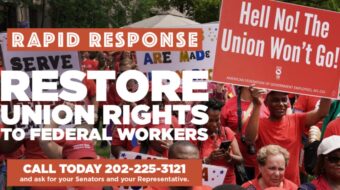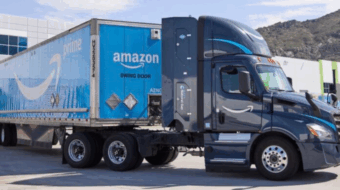
LOS ANGELES—The way events are rushing onwards in Los Angeles, what’s been the national capital of labor activism for much of 2023 may be the national epicenter of a historic strike wave by the fall of 2023. Or, as SAG-AFTRA President Fran Drescher told one interviewer, “Here we go again.”
That’s because if bosses keep pushing workers and refusing to bargain realistically, there would be four —or five—concurrent strikes in this city by midnight on September 30. And that’s not counting any local factories of the Detroit 3 auto companies.
Two strikes have been going for months: The Association of Motion Picture and Television Producers forced their 11,500 screenwriters of the Writers Guild of America out in May, followed by the same drill against the 168,000 members of SAG-AFTRA nationwide in July.
Then the city’s hotels refused to talk with Unite HERE Local 11 about paying their staffers enough to live on in high-cost L.A. That forced 32,000 hotel workers to walk. They usually clean guest rooms, serve in eateries and bars, and handle janitorial tasks, among other duties. They’re still out.
The fourth forced strike was forecast on Labor Day, with a strike authorization vote pending among the 85,000 union workers nationwide at Kaiser hospitals and clinics.
Sit down in the streets
Other cities had Labor Day parades, as did Los Angeles. It also had a Labor Day sit-down protest in the streets.
Members of the 14 local Coalition of Kaiser Permanente Unions (CKPU), took their cause—low pay, short-staffing, and refusal to bargain by a hospital chain whose managers garner millions—public by the street protest in front of the Kaiser’s largest L.A. hospital, in Hollywood. Police arrested 23.
And one of CKPU’s 14 unions, Service Employees Local 105 in Colorado, has already authorized the strike, 99%-1%. The CKPU contract(s) with Kaiser expire September 30.
Forced strike #4 may become forced strike #5. Top video game makers are treating their creative talent—the performers whose characters appear on your PlayStation—like the movie, TV and video moguls are treating other SAG-AFTRA performers. So the video performers, whose pact expired a year ago, are taking a strike authorization vote.
If that authorization is OK’d, those workers will be forced to walk on September 25. All to combat corporate greed.
The most notable manifestation of the determination of L.A.’s workers came on Labor Day. Other cities hosted Labor Day parades. So did L.A. But it had the street sit down in front of Kaiser’s big Hollywood hospital, too. They didn’t budge, so the cops toted 23 of them to jail.
The bulletin from Kaiser unions’ bargaining committee to their 14 unions’ 85,000 workers, plus comments from the workers, many of them RNs, make it clear that negotiations with the giant health care system have barely budged on major issues, although one, the short-staffing crisis has eased, not ended.
“With 37 days left before our contract expires, Kaiser still hasn’t made any proposal to raise wages for healthcare workers even after the pandemic and inflation,” the bargaining committee told CKPU members just before Labor Day.
“For three days, management would not present any proposal to our national bargaining team. This is unheard of in the 25 years of our partnership. The only economic proposal they made was to slash the value of our PSP (performance sharing program bonus for pandemic work) by capping it at $1,400.
“They still do not want to guarantee a PSP payout for us, although managers would continue to get bonuses regardless of Kaiser’s finances. We were clear with Kaiser that this was not something we were going to accept.
“Based on Kaiser’s priorities, it’s clear we are very far apart. While we continue to insist on wages that keep up with inflation and real solutions to the short staffing crisis, KP management has made no proposal to raise wages, tried to slash our PSP bonus, and is nowhere to be found when it comes to investing in workforce training, limiting outsourcing and so many other important priorities.”
Many hospital and clinic vacancies
One other big one: 10,000 vacancies at the Kaiser health system hospitals and clinics. The bargaining committee conceded recent Kaiser hiring in California has lessened the current short-staffing crisis at the hospitals, in a state where unions pioneered safe-staffing mandates. But the bargainers want contract language committing Kaiser bosses to a permanent solution.
In plain language, raise pay enough so you can hire people to staff your hospitals.
“Meanwhile, Kaiser Permanente earned nearly $3.3 billion in net income during the first half of 2023,” one news story said. And lots of cash went to Kaiser corporate pooh-bahs.
Kaiser is technically a non-profit, so it did not appear on the AFL-CIO’s Executive Paywatch, which covers publicly traded firms. But Kaiser’s mandated IRS Form 990—which is public–said CEO Greg Adams walked off in 2022 with $16.27 million in total compensation. And 68 other Kaiser honchos garnered at least $1 million each.
The Coalition of Kaiser Permanente Unions, which includes two Office and Professional Employees locals, SEIU-United Health Care Workers West, and 11 others, adds Kaiser’s been investing its profits in property, not people: “$113 billion in the U.S. and abroad, including in fossil fuels, casinos, for-profit prisons, alcohol companies, military weapons, and more.”
Health care, too. Kaiser’s most recent purchase, at what analysts considered a bargain price in April, was the renowned Geisinger Health Care System complex in northeastern Pennsylvania.
The contrasts led to the Labor Day sit down in the street in front of Kaiser’s biggest and main hospital in L.A. One really pissed worker opened up to the Los Angeles Times.
“We are burnt out, stretched thin, and fed up after years of the pandemic and chronic short staffing,” said Datosha Williams, a service rep at Kaiser Permanente South Bay. Kaiser’s bosses “are failing workers and patients, and we are at crisis levels in our hospitals and medical centers.
“Our employers take in billions of dollars in profits, yet they refuse to safely staff their facilities or pay many of their workers a living wage. We are prepared to do whatever it takes, even get arrested in an act of civil disobedience, to stand up for our patients.”
At SAG-AFTRA, the video game workers face the same issues as the TV, movie, and streaming video performers. They include low-ball pay offers from the bosses’ coalition, no residuals, and, of course, the video game makers ready to use computer-generated artificial intelligence to replace human beings: Record a video performer’s voice, mannerisms, body, and costumes once, then use them forever, mixing and matching and melding, without paying.
AMPTP wants to impose that on the writers and performers of stage, screen, and streaming services, too. Artificial intelligence would cost workers—on stage, in movies, on TV, and on Netflix–jobs and money, lots of money. Ditto for SAG-AFTRA’s video game workers.,
No wonder Fran Drescher said, “Here we go again.” By the end of September, you could say the same about much of working Los Angeles.
We hope you appreciated this article. At People’s World, we believe news and information should be free and accessible to all, but we need your help. Our journalism is free of corporate influence and paywalls because we are totally reader-supported. Only you, our readers and supporters, make this possible. If you enjoy reading People’s World and the stories we bring you, please support our work by donating or becoming a monthly sustainer today. Thank you!










